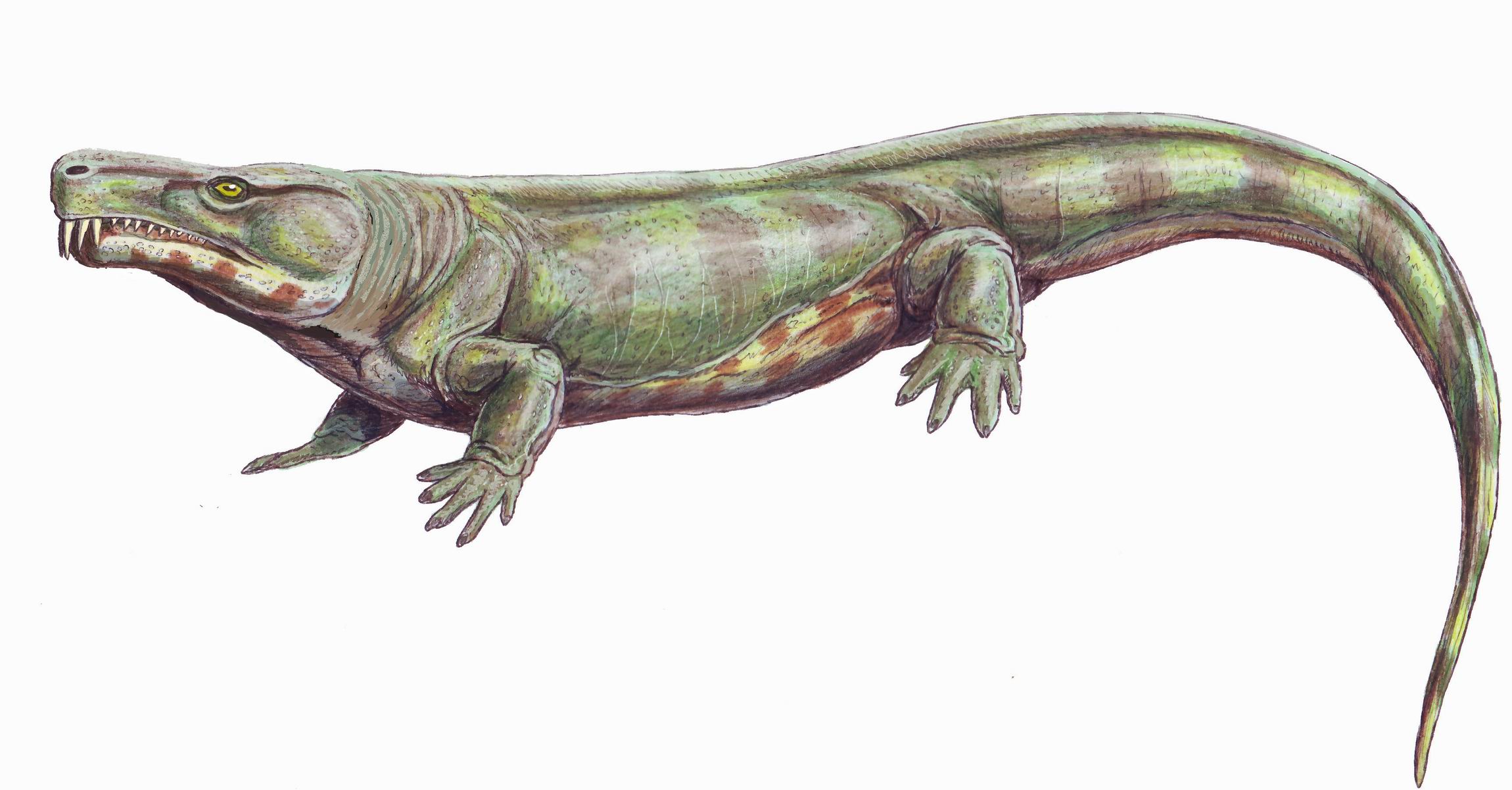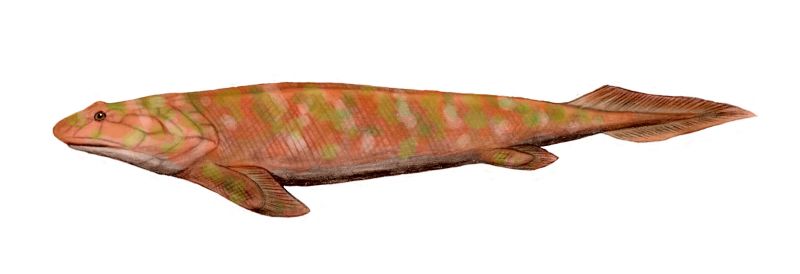|
Tulerpeton
''Tulerpeton'' is an extinct genus of Devonian four-limbed vertebrate, known from a fossil that was found in the Tula Region of Russia at a site named Andreyevka. This genus and the closely related ''Acanthostega'' and ''Ichthyostega'' represent the earliest tetrapods. Description ''Tulerpeton'' is considered one of the first "tetrapods" (in the broad sense of the word) to have evolved. It is known from a fragmented skull, the left side of the pectoral girdle, and the entire right forelimb and right hindlimb along with a few belly scales. This species is differentiated from the less derived "aquatic tetrapods" (such as ''Acanthostega'' and ''Ichthyostega'') by a strengthened limb structure. These limbs consist of 6 toes and fingers. Additionally, its limbs appear to have evolved for powerful paddling rather than walking. The fossil fragments also indicate that its head was disconnected from the pectoral girdle. From the absence of the rough postbranchial lamina of the pectoral gi ... [...More Info...] [...Related Items...] OR: [Wikipedia] [Google] [Baidu] |
Temnospondyli
Temnospondyli (from Greek τέμνειν, ''temnein'' 'to cut' and σπόνδυλος, ''spondylos'' 'vertebra') is a diverse order of small to giant tetrapods—often considered primitive amphibians—that flourished worldwide during the Carboniferous, Permian, and Triassic periods. A few species continued into the Jurassic and Cretaceous periods. Fossils have been found on every continent. During about 210 million years of evolutionary history, they adapted to a wide range of habitats, including freshwater, terrestrial, and even coastal marine environments. Their life history is well understood, with fossils known from the larval stage, metamorphosis, and maturity. Most temnospondyls were semiaquatic, although some were almost fully terrestrial, returning to the water only to breed. These temnospondyls were some of the first vertebrates fully adapted to life on land. Although temnospondyls are considered amphibians, many had characteristics, such as scales and armour-like bo ... [...More Info...] [...Related Items...] OR: [Wikipedia] [Google] [Baidu] |
Tetrapod
Tetrapods (; ) are four-limb (anatomy), limbed vertebrate animals constituting the superclass Tetrapoda (). It includes extant taxon, extant and extinct amphibians, sauropsids (reptiles, including dinosaurs and therefore birds) and synapsids (pelycosaurs, extinct therapsids and all extant mammals). Tetrapods evolved from a clade of primitive semiaquatic animals known as the Tetrapodomorpha which, in turn, evolved from ancient lobe-finned fish (sarcopterygians) around 390 million years ago in the Middle Devonian, Middle Devonian period; their forms were transitional between lobe-finned fishes and true four-limbed tetrapods. Limbed vertebrates (tetrapods in the broad sense of the word) are first known from Middle Devonian trackways, and body fossils became common near the end of the Late Devonian but these were all aquatic. The first crown group, crown-tetrapods (last common ancestors of extant tetrapods capable of terrestrial locomotion) appeared by the very early Mississippian ( ... [...More Info...] [...Related Items...] OR: [Wikipedia] [Google] [Baidu] |
Famennian
The Famennian is the latter of two faunal stages in the Late Devonian Epoch. The most recent estimate for its duration estimates that it lasted from around 371.1 million years ago to 359.3 million years ago. An earlier 2012 estimate, still used by the International Commission on Stratigraphy, estimated that it lasted from million years ago to million years ago. It was preceded by the Frasnian stage and followed by the Tournaisian stage. Major events In the seas, a novel major group of ammonoid cephalopods called clymeniids appeared, underwent tremendous diversification and spread worldwide, then just as suddenly went extinct. The beginning of the Famennian is marked by the final stages of a major extinction event, the Kellwasser Event, which is the largest component of the Late Devonian Mass extinction. The end of the Famennian experiences a smaller but still quite severe extinction event, the Hangenberg Event. A brief episode of glaciation, possibly linked to the Han ... [...More Info...] [...Related Items...] OR: [Wikipedia] [Google] [Baidu] |
Lepospondyli
Lepospondyli is a diverse taxon of early tetrapods. With the exception of one late-surviving lepospondyl from the Late Permian of Morocco ('' Diplocaulus minumus''), lepospondyls lived from the Early Carboniferous (Mississippian) to the Early Permian and were geographically restricted to what is now Europe and North America. Five major groups of lepospondyls are known: Adelospondyli; Aïstopoda; Lysorophia; Microsauria; and Nectridea. Lepospondyls have a diverse range of body forms and include species with newt-like, eel- or snake-like, and lizard-like forms. Various species were aquatic, semiaquatic, or terrestrial. None were large (the biggest genus, the diplocaulid '' Diplocaulus'', reached a meter in length, but most were much smaller), and they are assumed to have lived in specialized ecological niches not taken by the more numerous temnospondyl amphibians that coexisted with them in the Paleozoic. Lepospondyli was named in 1888 by Karl Alfred von Zittel, who coined the ... [...More Info...] [...Related Items...] OR: [Wikipedia] [Google] [Baidu] |
Late Devonian Animals
Late may refer to: * LATE, an acronym which could stand for: ** Limbic-predominant age-related TDP-43 encephalopathy, a proposed form of dementia ** Local-authority trading enterprise, a New Zealand business law ** Local average treatment effect, a concept in econometrics Music * ''Late'' (album), a 2000 album by The 77s * Late!, a pseudonym used by Dave Grohl on his '' Pocketwatch'' album * Late (rapper), an underground rapper from Wolverhampton * "Late" (song), a song by Blue Angel * "Late", a song by Kanye West from ''Late Registration'' Other * Late (Tonga), an uninhabited volcanic island southwest of Vavau in the kingdom of Tonga * "Late" (''The Handmaid's Tale''), a television episode * LaTe, Oy Laivateollisuus Ab, a defunct shipbuilding company * Late may refer to a person who is Dead See also * * * ''Lates ''Lates'' is a genus of freshwater and euryhaline lates perches belonging to the family Latidae. The generic name is also used as a common name, lates, for m ... [...More Info...] [...Related Items...] OR: [Wikipedia] [Google] [Baidu] |
Reptiliomorph
Reptiliomorpha (meaning reptile-shaped; in PhyloCode known as ''Pan-Amniota'') is a clade containing the amniotes and those tetrapods that share a more recent common ancestor with amniotes than with living amphibians (lissamphibians). It was defined by Michel Laurin (2001) and Vallin and Laurin (2004) as the largest clade that includes ''Homo sapiens'', but not '' Ascaphus truei'' (tailed frog). Laurin and Reisz (2020) defined Pan-Amniota as the largest total clade containing ''Homo sapiens'', but not '' Pipa pipa'', '' Caecilia tentaculata'', and '' Siren lacertina''. The informal variant of the name, "reptiliomorphs", is also occasionally used to refer to stem-amniotes, i.e. a grade of reptile-like tetrapods that are more closely related to amniotes than they are to lissamphibians, but are not amniotes themselves; the name is used in this meaning e.g. by Ruta, Coates and Quicke (2003). An alternative name, "Anthracosauria", is also commonly used for the group, but is confusi ... [...More Info...] [...Related Items...] OR: [Wikipedia] [Google] [Baidu] |
Michael Benton
Michael James Benton One or more of the preceding sentences incorporates text from the royalsociety.org website where: (born 8 April 1956) is a British palaeontologist, and professor of vertebrate palaeontology in the School of Earth Sciences at the University of Bristol. His published work has mostly concentrated on the evolution of Triassic reptiles but he has also worked on extinction events and faunal changes in the fossil record. Education Benton was educated at Robert Gordon's College, the University of Aberdeen and Newcastle University where he was awarded a PhD in 1981. Research and career Benton's research investigates palaeobiology, palaeontology, and macroevolution. His research interests include: diversification of life, quality of the fossil record, shapes of phylogenies, age-clade congruence, mass extinctions, Triassic ecosystem evolution, basal diapsid phylogeny, basal archosaurs, and the origin of the dinosaurs. He has made fundamental contributions to unde ... [...More Info...] [...Related Items...] OR: [Wikipedia] [Google] [Baidu] |
Whatcheeriidae
Whatcheeriidae is an extinct family of tetrapods which lived in the Mississippian sub-period, a subdivision of the Carboniferous period. It contains the genera ''Pederpes'', '' Whatcheeria'', and possibly '' Ossinodus''. Fossils of a possible whatcheeriid have been found from the Red Hill locality of Pennsylvania. If these remains are from a whatcheeriid, they extend the range of the family into the Late Devonian and suggest that advanced tetrapods may have lived alongside primitive tetrapod ancestors like ''Hynerpeton'' and ''Densignathus''. They also imply that a very long ghost lineage of whatcheeriids lived through Romer's gap, a period during the Early Carboniferous conspicuously lacking in tetrapod remains. Classification Currently, using modern cladistic taxonomy, Whatcheeriidae is not placed in Amphibia Amphibians are tetrapod, four-limbed and ectothermic vertebrates of the Class (biology), class Amphibia. All living amphibians belong to the group Lissamphibi ... [...More Info...] [...Related Items...] OR: [Wikipedia] [Google] [Baidu] |
Colosteidae
Colosteidae is a family of stegocephalians (tetrapod-like vertebrates) that lived in the Carboniferous period. They possessed a variety of characteristics from different tetrapod or stem-tetrapod groups, which made them historically difficult to classify. They are now considered to be part of a lineage intermediate between the earliest Devonian terrestrial vertebrates (such as ''Ichthyostega''), and the different groups ancestral to all modern tetrapods, such as temnospondyls (probably ancestral to modern amphibians) and reptiliomorphs (ancestral to amniotes such as mammals, reptiles, and birds). Description Colosteids had elongated bodies, with an estimated 40 vertebrae, not including the tail. The skull is flat and composed of many separate bones, like that of other stegocephalians. Colosteids lacked otic notches at the back of the head, unlike temnospondyls and other "labyrinthodonts". However, they did possess large mandibular and palatal fangs (on the lower jaw and t ... [...More Info...] [...Related Items...] OR: [Wikipedia] [Google] [Baidu] |
Baphetidae
Baphetidae is an extinct family of early tetrapods. Baphetids were large labyrinthodont predators of the Late Carboniferous period (Namurian through Westphalian) of Europe. Fragmentary remains from the Early Carboniferous of Canada have been tentatively assigned to the group. The phylogenetic relationships of baphetids is uncertain; while many studies have placed the group as a close relative of Amniota, other analyses have found Baphetidae to be a more basal clade of early stem tetrapods. Baphetids were among the first of the Carboniferous fossil tetrapods to be found and were originally described in 1850 by John William Dawson. The baphetids have been referred to the family Loxommatidae, but this group was later shown to be a junior synonym of Baphetidae, which was named earlier in 1865. Baphetids are known mainly from skulls; very little postcranial material has been found. Palaeobiology The presence of lateral lines and the long rows of needle-like teeth show that most were ... [...More Info...] [...Related Items...] OR: [Wikipedia] [Google] [Baidu] |
Embolomeri
Embolomeri is an order of tetrapods or stem-tetrapods, possibly members of Reptiliomorpha. Embolomeres first evolved in the Early Carboniferous (Mississippian) Period and were the largest and most successful predatory tetrapods of the Late Carboniferous (Pennsylvanian) Period. They were specialized semiaquatic predators with long bodies for eel-like undulatory swimming. Embolomeres are characterized by their vertebral centra, which are formed by two cylindrical segments, the pleurocentrum at the rear and intercentrum at the front. These segments are equal in size. Most other tetrapods have pleurocentra and intercentra which are drastically different in size and shape. Embolomeres were among the earliest large carnivorous tetrapods, with members such as the crocodilian-like '' Proterogyrinus'' appearing in the Visean stage of the Carboniferous. They declined in diversity during the Permian period, though at least one representative ('' Archeria)'' was common in the Early Permia ... [...More Info...] [...Related Items...] OR: [Wikipedia] [Google] [Baidu] |



